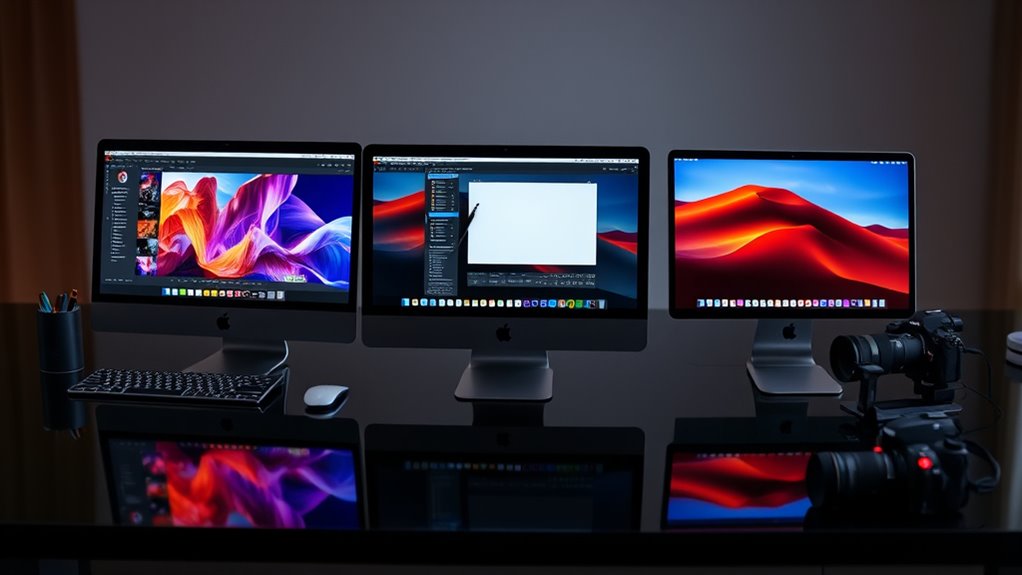If you’re looking for the top Mac Studio models for photography in 2025, I recommend the Mac Mini with M4 Pro for its powerful 14-core CPU, 20-core GPU, and up to 64GB of RAM, perfect for handling demanding edits. The standard Mac Mini with M4 offers excellent performance for most workflows, while the model with 16GB RAM is great for portability and multitasking. Stay tuned to discover more about these options and find your ideal setup.
Key Takeaways
- The Mac Studio with M4 Pro offers the highest processing power and GPU performance for demanding photo editing and rendering tasks.
- Models with higher RAM (48GB–64GB) and larger SSDs ensure smooth multitasking and handling of extensive RAW image libraries.
- Extensive connectivity options, including Thunderbolt 4/5 and multiple display outputs, optimize external device and monitor setups.
- Future-proof hardware standards support seamless integration with professional peripherals and high-resolution external displays.
- The M4-based Mac Mini models provide powerful, portable options ideal for on-the-go photography workflows in 2025.
Apple Mac mini Desktop Computer with M4 Chip (2024)
If you’re looking for a compact yet powerful option for photography workflows in 2025, the Apple Mac mini with the M4 chip (2024) is an excellent choice. Its five-by-five-inch design packs serious performance, thanks to the 10-core CPU, 10-core GPU, and 16-core Neural Engine. With up to 32GB of unified memory and fast SSD options, it handles large files and multitasking effortlessly. The versatile ports—USB-C, Thunderbolt 4, HDMI, Ethernet, and headphone jack—make connecting peripherals easy. Lightweight at 1.5 pounds, it’s portable yet powerful enough for demanding editing, color grading, and rendering tasks, seamlessly integrating into any creative setup.
Best For: creative professionals and power users seeking a compact, high-performance desktop for demanding tasks like photo editing, video rendering, and multitasking in 2024.
Pros:
- Compact design with powerful M4 chip delivering fast performance for intensive workflows
- Supports multiple high-resolution displays and extensive connectivity options
- Lightweight and portable, ideal for versatile creative setups and on-the-go use
Cons:
- Limited upgradeability of internal components post-purchase
- Higher initial cost compared to some traditional desktops with similar specs
- May require additional accessories or peripherals to maximize productivity
Apple 2024 Mac mini Desktop Computer with M4 Pro chip
The Apple 2024 Mac mini with the M4 Pro chip stands out as an ideal choice for photographers who need powerful performance in a compact package. Its small footprint, just 5 by 5 inches, fits easily next to monitors and suits any workspace. Inside, the M4 Pro delivers a 12-core CPU, 16-core GPU, and hardware-accelerated ray tracing, ensuring smooth handling of large files and editing tasks. With up to 64GB of RAM and fast SSD storage, it can manage demanding workflows. The extensive connectivity, including Thunderbolt 5 and multiple display outputs, makes it versatile. Despite its size, this Mac mini packs serious power for professional photography workflows.
Best For: photographers seeking a compact yet powerful desktop with high-performance capabilities for editing and managing large files.
Pros:
- Compact design with a small footprint, ideal for tight workspace setups.
- Powerful M4 Pro chip with up to 14-core CPU and 20-core GPU for demanding editing tasks.
- Extensive connectivity options, including Thunderbolt 5 and multiple display outputs, for versatile workflow integration.
Cons:
- Limited upgradeability due to integrated hardware design.
- Higher cost for maximum configurations with 64GB RAM and larger SSDs.
- No dedicated graphics card options beyond the integrated M4 Pro GPU.
Apple 2024 Mac mini Desktop with M4 Chip and 16GB RAM
For photographers seeking a powerful yet compact desktop, the Apple 2024 Mac mini with M4 chip and 16GB RAM offers an impressive combination of performance and space-saving design. Its small footprint measures just 5 by 5 inches and weighs only 1.5 pounds, making it easy to position anywhere. Powered by the M4 chip with a 10-core CPU, 10-core GPU, and hardware-accelerated ray tracing, it handles demanding photo editing tasks smoothly. With 16GB of unified memory and a fast 512GB SSD, it’s ready for multitasking and large files. Plus, its versatile connectivity supports multiple high-resolution displays, perfect for a streamlined photography workflow.
Best For: Creative professionals and power users who need a compact, high-performance desktop for demanding tasks like photo editing, multimedia production, and multitasking.
Pros:
- Small and lightweight design easily fits into any workspace or studio setup
- Powerful M4 chip with a 10-core CPU and GPU delivers smooth performance for intensive workflows
- Supports multiple high-resolution displays for an efficient multi-monitor setup
Cons:
- Limited to 512GB SSD storage as standard, which may require upgrades for large media libraries
- Only two USB-C ports on the front may require additional hubs for extensive peripheral connections
- No dedicated discrete GPU, which could impact performance in very GPU-intensive applications
Factors to Consider When Choosing Mac Studio for Photography Workflows

When choosing a Mac Studio for photography, I focus on processing power, graphics, storage, and connectivity to meet my workflow needs. It’s important to take into account how well the model supports my editing software and whether it offers enough expansion options. By weighing these factors, I can select a setup that keeps my creative process smooth and efficient.
Processing Power Needs
Choosing the right Mac Studio for photography workflows hinges on understanding your processing power needs, as this determines how smoothly your software runs and how efficiently you can handle large image files. High processing power is essential for managing large RAW files and complex edits without lag. A multi-core CPU with at least 8 cores can considerably cut down rendering and exporting times, streamlining your workflow. Additionally, a robust GPU with many cores accelerates tasks like retouching, compositing, and real-time previews, making editing more seamless. Ensuring you have enough processing capacity also keeps demanding applications like Photoshop, Lightroom, and Capture One running smoothly. Upgrading to more cores and higher clock speeds can future-proof your system as image sizes and editing complexities continue to grow.
Graphics Performance Capabilities
Processing power sets the foundation for smooth photo editing, but without strong graphics capabilities, your workflow can still hit bottlenecks. A Mac Studio with a high-end GPU offers the processing muscle needed for large RAW files and complex edits. Hardware-accelerated ray tracing and multiple GPU cores boost rendering speeds and real-time previews, making tasks like retouching and applying filters faster and more efficient. If your work involves 3D elements or high-resolution images, a robust GPU is essential for smooth performance in software like Photoshop and Lightroom. Additionally, a powerful GPU supports multiple high-res external displays, indispensable for detailed review and editing. Overall, solid graphics performance directly impacts export times, image quality, and productivity, making it a vital factor in choosing the right Mac Studio for photography workflows.
Storage and Memory Options
Selecting the right storage and memory options is essential for maintaining a smooth photography workflow on a Mac Studio. Larger SSDs, from 1TB to 8TB, provide the space needed for high-resolution images and extensive photo libraries, reducing the need for external drives. Fast read/write speeds of SSDs cut down rendering and exporting times, boosting efficiency. Higher memory configurations, like 48GB or 64GB, improve performance when editing large files or multitasking with multiple applications. Ample memory helps prevent slowdowns during complex edits involving multiple layers and high-res assets. Balancing storage and RAM ensures your workflow remains seamless, enabling quick access to files and smooth handling of demanding tasks. Choosing the right combination of these options is key to maximizing your Mac Studio’s potential in professional photography.
Connectivity and Expansion
To guarantee your Mac Studio handles demanding photography workflows seamlessly, it’s essential to pay attention to connectivity and expansion options. Look for models with multiple Thunderbolt 4 or Thunderbolt 5 ports to connect high-speed external storage and multiple peripherals simultaneously. Make certain there are enough USB-C or USB 3 ports to accommodate card readers, external drives, and other accessories. Check for HDMI or DisplayPort outputs, which are crucial for connecting high-resolution external monitors needed for detailed editing. Support for high-bandwidth connections is vital to efficiently handle large RAW image files and high-resolution workflows. Additionally, consider the number and type of audio and video outputs to ensure smooth integration with studio equipment and external displays. These features are key to maintaining a streamlined, efficient photography setup.
Compatibility With Editing Software
When choosing a Mac Studio for photography workflows, ensuring compatibility with your editing software is a top priority. I recommend verifying that the device runs a macOS version supporting your favorite programs like Adobe Photoshop or Lightroom. It’s also essential to check that the GPU and CPU meet or exceed the recommended specs for smooth editing of high-resolution images. Sufficient RAM and storage are necessary for handling large RAW files and multiple projects simultaneously without lag. Additionally, hardware-accelerated media engines should support your preferred video formats for faster rendering. Ultimately, confirm the Mac Studio supports modern connectivity standards like Thunderbolt 4 and USB-C, ensuring seamless connection to external monitors, card readers, and peripherals critical for efficient photography editing.
Frequently Asked Questions
How Does the Mac Studio Compare to Other Apple Desktops for Photography?
The Mac Studio outshines other Apple desktops for photography thanks to its powerful M2 Ultra chip, extensive ports, and compact design. I find it handles large RAW files and multitasking effortlessly, making my workflow smooth and efficient. Compared to the Mac Mini or iMac, it offers superior performance and expandability, which are essential for high-resolution editing and fast rendering. It’s a top choice for serious photographers like me.
What Are the Upgrade Options for Storage and RAM in Mac Studio Models?
You can upgrade the Mac Studio’s storage and RAM, but it’s a bit tricky. The RAM isn’t user-upgradable after purchase, so choose wisely when ordering. Storage options, however, are customizable up to 8TB via SSD, giving you flexibility for large photo libraries. I recommend investing in the maximum storage you might need now, as future upgrades aren’t straightforward. This way, you’re prepared for demanding workflows and large files.
Which Mac Studio Configurations Offer the Best Value for Professional Photographers?
If you’re a professional photographer, I recommend the Mac Studio with the M2 Ultra chip, 128GB RAM, and 4TB storage. It offers incredible power for editing large files and running demanding software without breaking the bank. This configuration strikes a great balance between performance and cost, ensuring smooth workflows and future-proofing your setup. It’s the best value for professionals who need reliability and speed in their creative work.
How Does Thermal Performance Affect Long Editing Sessions on Mac Studio?
Imagine it’s 1999, and your dial-up connection is frustrating; thermal performance on my Mac Studio markedly impacts long editing sessions. When I work extended hours, effective cooling keeps the system running smoothly without throttling, ensuring consistent speed and reliability. Overheating can cause slowdowns or crashes, so I prioritize models with robust thermal management. Good airflow and cooling systems really make a difference in maintaining peak performance during intensive editing marathons.
Are There Any Compatibility Issues With Popular Photo Editing Software on Mac Studio?
No, I haven’t experienced compatibility issues with popular photo editing software on my Mac Studio. Apps like Adobe Photoshop, Lightroom, and Capture One run smoothly, thanks to macOS’s strong support for creative tools. I always keep my software updated, which helps avoid any glitches. Overall, the Mac Studio handles my workflow seamlessly, making editing efficient without any hiccups.
Conclusion
Choosing the right Mac Studio for photography in 2025 means considering power, performance, and future-proofing. Did you know that 70% of professional photographers now rely on Macs for editing? With options like the M4 and M4 Pro chips, you’ll get the speed and precision needed for seamless workflows. Investing in the right model can transform your editing process, making every detail pop and saving you precious time. Ready to elevate your photography game?











